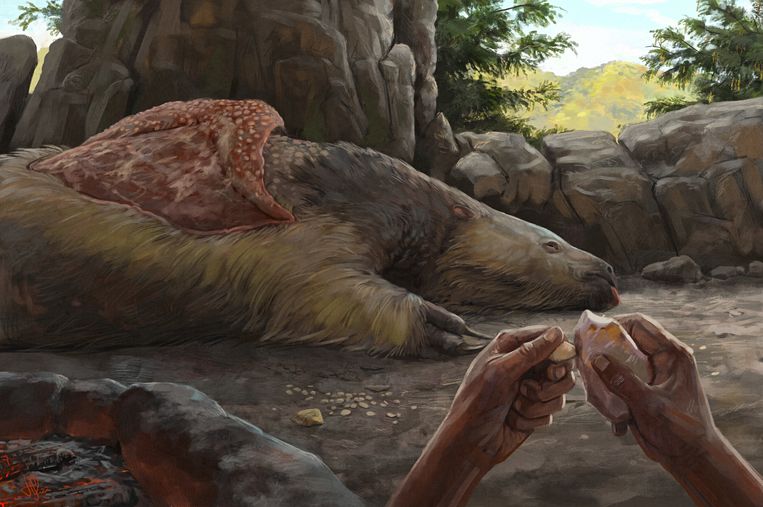
A hole in the bone of a giant sloth that reverses Brazil’s first Homo sapiens
Brazilian scientists have come to the conclusion that Homo sapiens that entered North America through the Bering Strait never spread further south. Homo sapiens roamed Brazil 25,000 years ago. Not only there. An invention that hasn’t gone down well yet.
The source comes from Santa Elena, in the state of Mato Grosso in the Midwest of Brazil. A savanna-like landscape, yet, many large mammals once lived: herbivores, predators and armadillos. Numerous animal remains have already been discovered at Santa Elena, as well as petroglyphs and vessels, a treasure trove for archaeologists and paleontologists. Fortunately, the findings were carefully removed. They are stored in the Archeology Museum at the University of São Paulo, says Mirian Pacheco, an archaeologist and researcher at the University of São Carlos in São Paulo state.
The hero of this story, the giant sloth, Glossotherium phenesis, lived in the Pleistocene about 25,000 years ago and weighed about five hundred kilograms. Standing upright, he can reach a height of six meters. Beneath his skin were bony plates that aided human processing well. It became extinct about 11,000 years ago.
From the giant sloth, the team led by Pacheco examines three bones with perfectly round holes that must have been man-made. They may have been utensils or jewellery; Researchers prefer to use the neutral term ‘artifacts’.
Sandblasted bones
The team has been busy with material for about five years. Pacheco: “We didn’t really intend to break a paradigm. We wanted to learn more about the provenance and characteristics of the artifacts. Pacheco and his colleagues concluded that human hands had worked the bones. They found that the bones had been sandblasted and tooled.
They concluded that the bones and humans were contemporaneous because the bones were eaten by rodents. They only bite into fresh bones, not fossilized bones. Pacheco: “People could have found fossilized bones later and edited them, but that’s not the case.”
The impact of that discovery is significant because the competition between artifacts and humans dates back 25,000 years and overturns the commonly accepted theory that Homo sapiens migrated from Asia about 15,000 years ago, across the Bering Strait that separates Alaska from the eastern tip of Russia. ., ended in America. From there, humans would have spread across North and then South America. However, many scientists believe that modern humans were already living in South America before crossing the Bering Strait 15,000 years ago.
This is not the first time that the prevailing theory from South America has been undermined. Pacheco: “It is generally accepted that Homo sapiens crossed the Bering Strait about 15,000 years ago. But in the northeast of Brazil, the well-known researcher Águeda Vialou found tools dating back 20,000 years.
Electron microscopes
Why did Pacheco and his colleagues make their discovery now and before? After all, the artifacts have been in the museum for decades. He explains it through improved technology. For example, researchers used electron microscopes to determine whether bones were ‘fresh’ by looking at how bones were polished by humans and using special light techniques (which Pacheco calls photoluminescence). They were already fossilized.
The publication appeared in the July issue of the magazine Proceedings of the Royal Society b. “We’ve had some official reactions from scientific circles, but the reception has been overwhelming so far. That’s okay, it’s pushing us to make a better argument,” Pacheco says over the phone with a happy laugh, “and we’re working on a second article to better explain how we used the technology.”
In this way, the Brazilians hope to break the paradigm and open the debate about the previous presence of Homo sapiens in South America. To support their theory, they are eager to return to the treasure house, where the prized possession of the giant sloth comes from Santa Elena, with its savanna landscape. Thanks to improved technology, even more material can be found out there, which will answer pressing questions. Pacheco: “We’re going to apply for financing.”

read more:
The Invention of America
We now know that Columbus did not actually discover America. It was the last continent to be discovered and populated. By whom? when Old answers to the question are under attack.

“Coffee fanatic. Friendly zombie aficionado. Devoted pop culture practitioner. Evil travel advocate. Typical organizer.”
